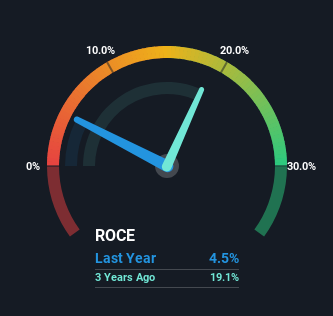Global Infotech (SZSE:300465) Is Finding It Tricky To Allocate Its Capital
When researching a stock for investment, what can tell us that the company is in decline? A business that's potentially in decline often shows two trends, a return on capital employed (ROCE) that's declining, and a base of capital employed that's also declining. Ultimately this means that the company is earning less per dollar invested and on top of that, it's shrinking its base of capital employed. In light of that, from a first glance at Global Infotech (SZSE:300465), we've spotted some signs that it could be struggling, so let's investigate.
Understanding Return On Capital Employed (ROCE)
For those that aren't sure what ROCE is, it measures the amount of pre-tax profits a company can generate from the capital employed in its business. The formula for this calculation on Global Infotech is:
Return on Capital Employed = Earnings Before Interest and Tax (EBIT) ÷ (Total Assets - Current Liabilities)
0.045 = CN¥31m ÷ (CN¥1.4b - CN¥678m) (Based on the trailing twelve months to June 2024).
Thus, Global Infotech has an ROCE of 4.5%. In absolute terms, that's a low return, but it's much better than the Software industry average of 2.9%.
View our latest analysis for Global Infotech

Historical performance is a great place to start when researching a stock so above you can see the gauge for Global Infotech's ROCE against it's prior returns. If you'd like to look at how Global Infotech has performed in the past in other metrics, you can view this free graph of Global Infotech's past earnings, revenue and cash flow.
What The Trend Of ROCE Can Tell Us
The trend of returns that Global Infotech is generating are raising some concerns. Unfortunately, returns have declined substantially over the last five years to the 4.5% we see today. In addition to that, Global Infotech is now employing 57% less capital than it was five years ago. The combination of lower ROCE and less capital employed can indicate that a business is likely to be facing some competitive headwinds or seeing an erosion to its moat. If these underlying trends continue, we wouldn't be too optimistic going forward.
While on the subject, we noticed that the ratio of current liabilities to total assets has risen to 50%, which has impacted the ROCE. Without this increase, it's likely that ROCE would be even lower than 4.5%. And with current liabilities at these levels, suppliers or short-term creditors are effectively funding a large part of the business, which can introduce some risks.
What We Can Learn From Global Infotech's ROCE
In summary, it's unfortunate that Global Infotech is shrinking its capital base and also generating lower returns. In spite of that, the stock has delivered a 4.1% return to shareholders who held over the last five years. Either way, we aren't huge fans of the current trends and so with that we think you might find better investments elsewhere.
On a final note, we found 2 warning signs for Global Infotech (1 is a bit unpleasant) you should be aware of.
While Global Infotech isn't earning the highest return, check out this free list of companies that are earning high returns on equity with solid balance sheets.
New: Manage All Your Stock Portfolios in One Place
We've created the ultimate portfolio companion for stock investors, and it's free.
• Connect an unlimited number of Portfolios and see your total in one currency
• Be alerted to new Warning Signs or Risks via email or mobile
• Track the Fair Value of your stocks
Have feedback on this article? Concerned about the content? Get in touch with us directly. Alternatively, email editorial-team (at) simplywallst.com.
This article by Simply Wall St is general in nature. We provide commentary based on historical data and analyst forecasts only using an unbiased methodology and our articles are not intended to be financial advice. It does not constitute a recommendation to buy or sell any stock, and does not take account of your objectives, or your financial situation. We aim to bring you long-term focused analysis driven by fundamental data. Note that our analysis may not factor in the latest price-sensitive company announcements or qualitative material. Simply Wall St has no position in any stocks mentioned.
About SZSE:300465
Global Infotech
Provides financial information software products and integrated services in China.
Exceptional growth potential with excellent balance sheet.
Market Insights
Community Narratives



